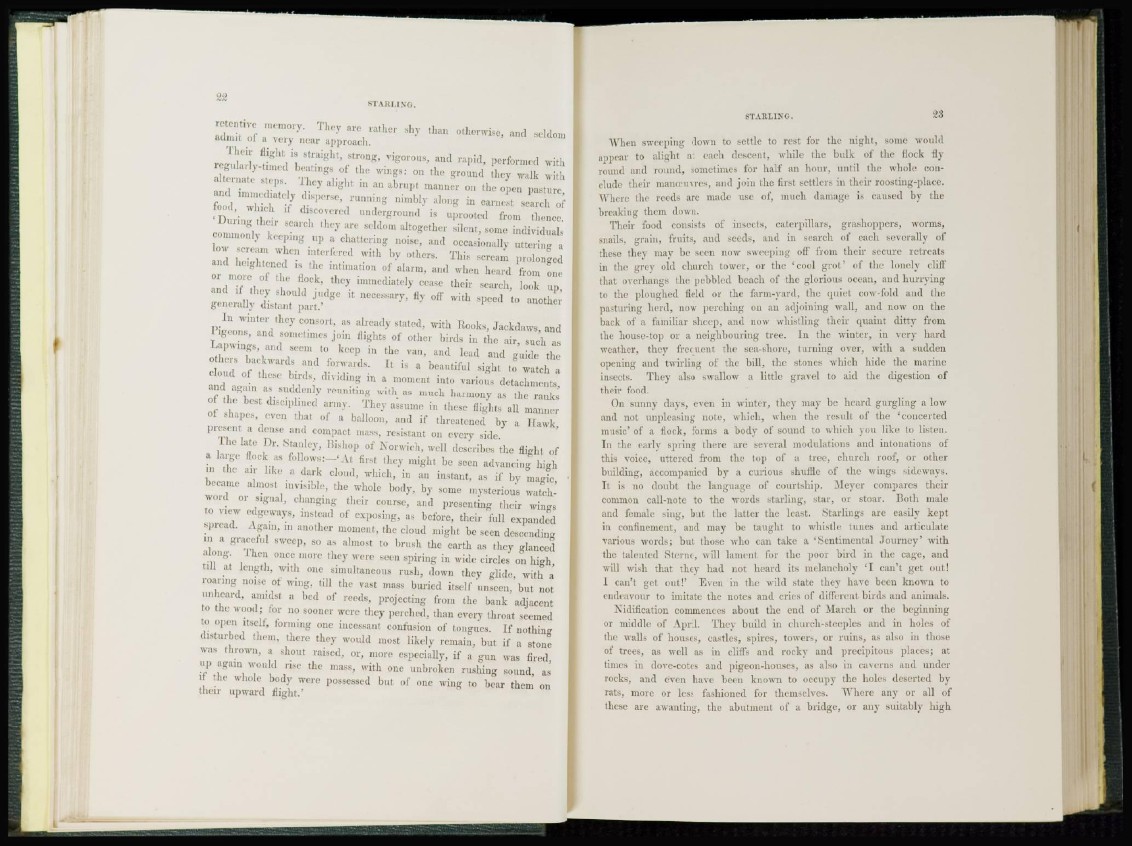
retentive memory. They are rather shy than otherwise, and seldom
admit of a very nejir approach.
Their flight is straight, strong, vigorous, and rapid, performed with
regularly-timed beatings of the wings: on the ground they walk with
alternate steps. They alight in an abrupt manner on the open pasture,
and immediately disperse, running nimbly along in earnest search of
food, which if discovered underground is uprooted from thence.
' D u r i n g their search they are seldom altogether silent, some individuals
commonly keeping up a chattering noise, and occasionally uttering a
low scream when interfered with by oilier-.. This scream prolonged
and heightened is the intimation of alarm, and when heard from one
or more of the flock, they immediately cease their search, look up,
and if they should judge it necessary, fly off with speed to another
generally distant part.'
I n winter they consort, as already stated, with Hooks, Jackdaws, and
Pigeons, and sometimes j o i n flights of other birds in the air, such as
Lapwings, and seem to keep in the van, and lead and guide the
O t h e r s backwards and forwards. It is a beautiful sight to watch a
cloud of these birds, dividing in a moment into various detachments,
and again as suddenly reuniting with as much harmony as the ranks
of the best disciplined army. They assume in these flights all manner
of shapes, even that of a balloon, and if threatened by a Hawk,
present a dense and compact mass, resistant on every side.
The late Dr. Stanley, llishop of Norwich, well describes the flight of
a large flock as follows:—'At first they might be seen advancing high
in the air like a dark cloud, which, in an instant, as if by magic,
became almost invisible, the whole bodyr , by some mysterious watchword
or signal, changing their course, and presenting their wings
ro view edgeways, instead of exposing, as before, their full expanded
spread. Again, in another moment, the cloud might be seen descending
in a graceful sweep, so as almost to brush the earth as they glanced
along. Then once more they were seen spiring in wide circles on high,
till at length, with one simultaneous rush, down they glide, with a
roaring noise of whig, till the vast mass buried itself unseen, but not
unheard, amidst a bed of reeds, projecting from the bank adjacent
to the wood; for no sooner were they perched, than e v e n throat seemed
to open itself, forming one incessant confusion of tongues. If nothing
disturbed them, there they would most likely remain, but if a stone
was thrown, a shout raised, or, more especially, if a gun was fired,
up again would rise the mass, with one unbroken rushing sound, as
if the whole body were possessed but of one wing to bear them on
their upward flight."
STARL1NO.
When sweeping down to settle to rest for the night, some would
appear to alight at each descent, while the bulk of the flock fly
round and round, sometimes for half an hour, until the whole conclude
their manoeuvres, ami join the first settlers in their roosting-place.
Where the reeds are made use of, much damage is caused by the
breaking them down.
Their food consists of insects, caterpillars, grashoppers, worms,
snails, grain, fruits, and seeds, and in search of each severally of
these they may be seen now sweeping off from their secure retreats
in the grey old church tower, or the 'cool grot' of the lonely cliff
that overhangs the pebbled beach of the glorious ocean, and hurrying
to the ploughed field or the farm-yard, the quiet cow - fold and the
pasturing herd, now perching on an adjoining wall, and now on the
back of a familiar sheep, and now whistling their quaint ditty from
the house-top or a neighbouring tree. In the winter, in very hard
weather, they frequent the sea-shore, turning over, with a sudden
opening and twirling of the bill, the stones which hide the marine
insects. They also swallow a little gravel to aid the digestion of
their food.
On sunny days, even in winter, they may be heard gurgling a low
and not nnpleasing note, which, when the result of the 'concerted
music* of a flock, forms a body of sound to which you like to listen.
In the early spring there are several modulations and intonations of
this voice, uttered from the top of ;i tree, church roof, or other
building, accompanied by a curious shuffle of the wings eidewaj 8.
It is no doubt the language of courtship. Meyer compares their
common call-note to the words starling, star, or stoar. Both male
and female- sing, but the latter the least. Starlings are easily kept
in confinement, and may be taught to whistle tunes and articulate
various words; but those who can take a 'Sentimental J o u r n e y ' with
the talented Sterne, will lament for the poor bird in the cage, and
will wish that they had not heard its melancholy ' 1 can't get out!
1 can't get out!' Even in the wild state they have been known to
endeavour to imitate the notes and cries of different birds and animals.
Nidification commences about the end of March or the beginning
or middle of April. They build in church-steeples and in holes of
the walls of houses, castles, spires, towers, or ruins, as also in those
of tree-, as well as in clifFs and rocky and precipitous places; at
times in dove-cotes and pigeon-houses, as also in caverns and under
rocks, and even have been known to occupy the holes deserted by
rats, more or less fashioned for themselves. Where any or all of
these are awanting, the abutment of a bridge, or any suitably high